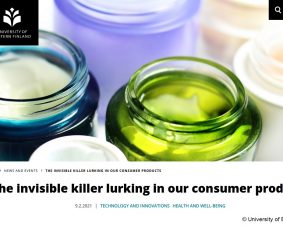 >
Spotlight Juli 2020: “Nanosafety – More than just regulatory processes”
>
Spotlight Juli 2020: “Nanosafety – More than just regulatory processes”
Nanosafety is more than just a compulsory aspect of nanomaterials research and regulation. This research area also has great potential to drive new innovations. It is exactly this perspective that is addressed in the special issue “Rethinking Nanosafety: Harnessing Progress and Driving Innovation” by Chen et al. 2020.
The article illustrates that especially in the field of biology and nanomedicine, safety assessment can contribute to a more fundamental mechanistic understanding of the interaction between nanomaterials and living systems. Innovations based on this can range from personalised nanomedicine to tailor-made nanomaterials for the agricultural industry. In addition, the development of advanced cell and tissue models could further advance the understanding of so-called “adverse outcome pathways” (AOPs) as well as their development and validation.
The Special issue Rethinking Nanosafety brings together more than 50 research projects of renowned scientists in the field of nanosafety and reflects the cooperative and future-oriented character of this research area. The first part of this special issue was published in Small in May 2020. The publication of the second part will follow in July 2020.
Original Publication:
Chen, C., Leong, D.T. and Lynch, I. (2020), Rethinking Nanosafety: Harnessing Progress and Driving Innovation. Small, 16: 2002503. DOI:10.1002/smll.202002503

Weitere Spotlights
Spotlight March 2021: Is Nanotechnology the Swiss Army Knife against Future Pandemics?
The COVID 19 outbreak has led to a fundamental rethinking of existing approaches to diagnosis, treatment, and prevention methods. The need for better and more efficient concepts is global and urgent. Nanotechnology has long been at the forefront of innovation and has led to advances in many different disciplines. Could this interdisciplinary field help develop […]
Read moreSpotlight March 2023: How can photovoltaics be made safe and sustainable?
Conventional photovoltaic systems often have only low efficiency, i.e. only a fraction of the solar energy is converted into electrical energy and made usable. For this reason, research is being conducted into innovative materials that can significantly increase the energy yield and thus also enable more electrical energy to be generated from renewable sources. However, […]
Read moreSpotlight April 2021: Nanomaterials and Fake News – a commentary based on an example
In February 2021, the article “The invisible killer lurking in our consumer products” appeared, describing nanoparticles as a greater danger than Corona [1]. “The use of nanomaterials” would be “unregulated” and “nanomaterials are so small that they cannot be determined once they are part of a product”. So what is the truth of these statements? […]
Read moreSpotlight December 2020: Rethinking Nanosafety – Part II
In December we would like to draw attention to the special issue: Rethinking Nanosafety – Part II in small. In the July Spotlight we already presented Part I. This special issue “Rethinking Nanosafety – Part II” also features research papers by renowned scientists in the field of nanosafety research. The first part of this special […]
Read more


